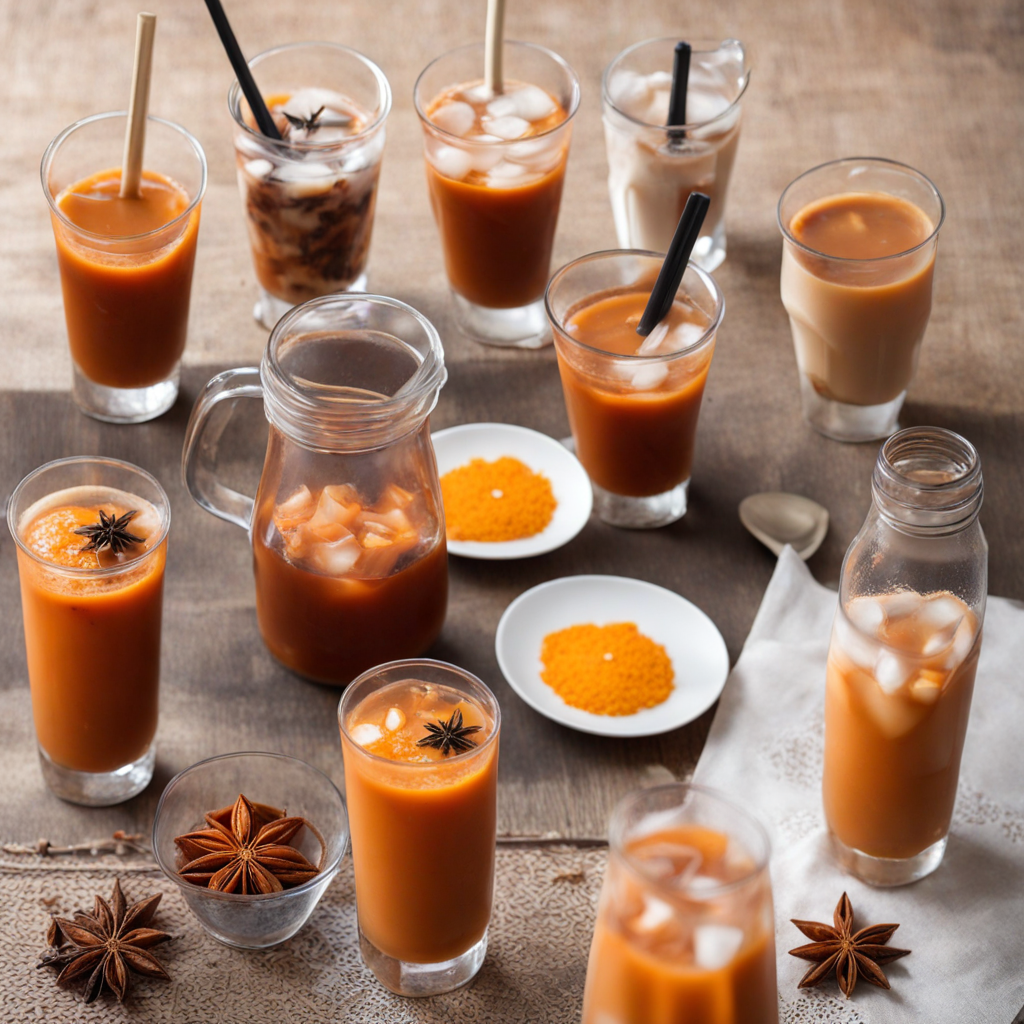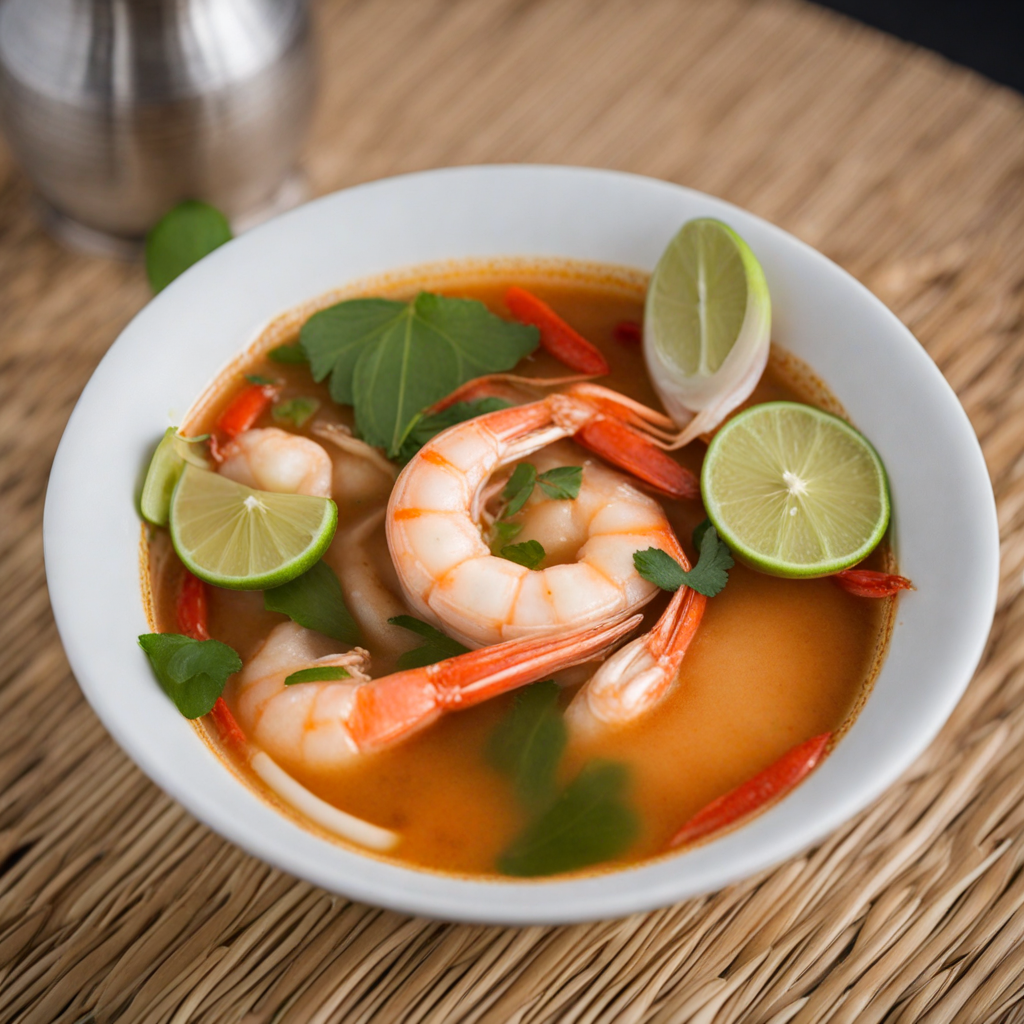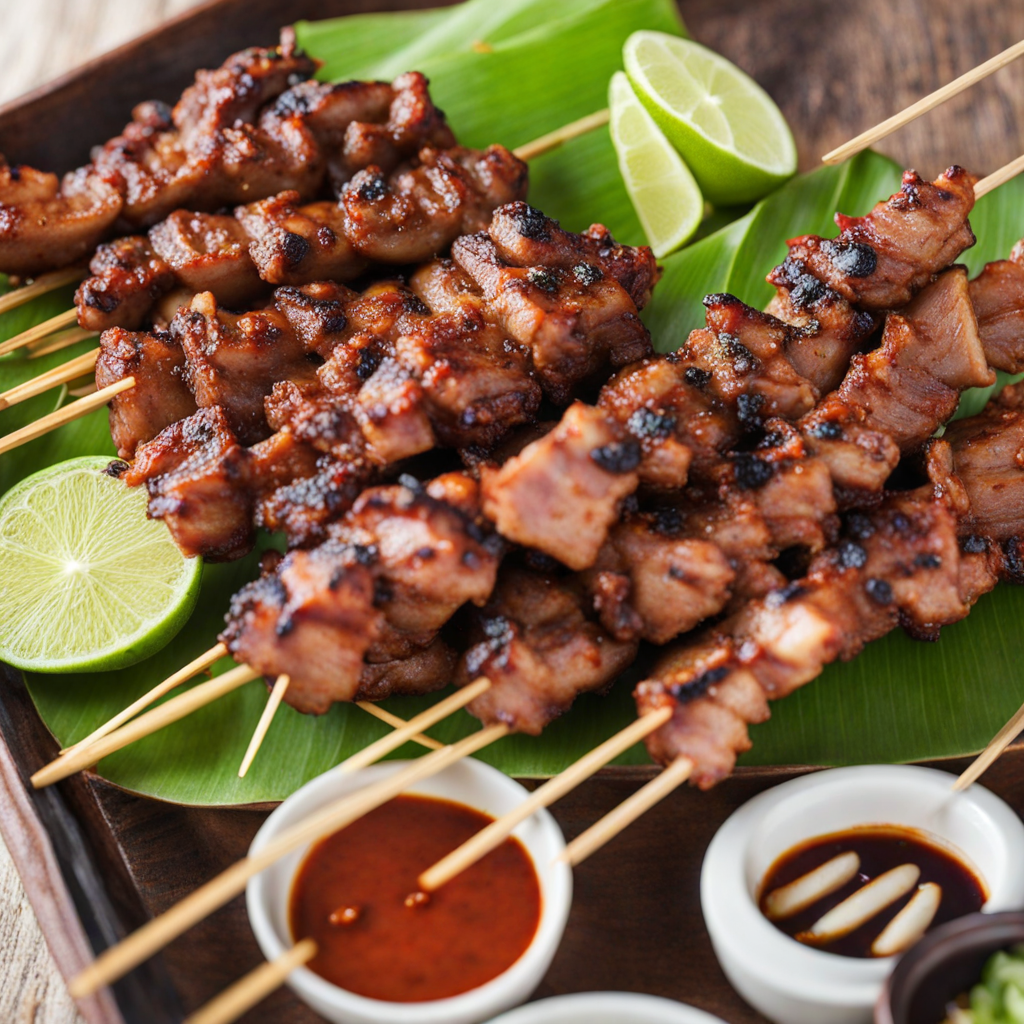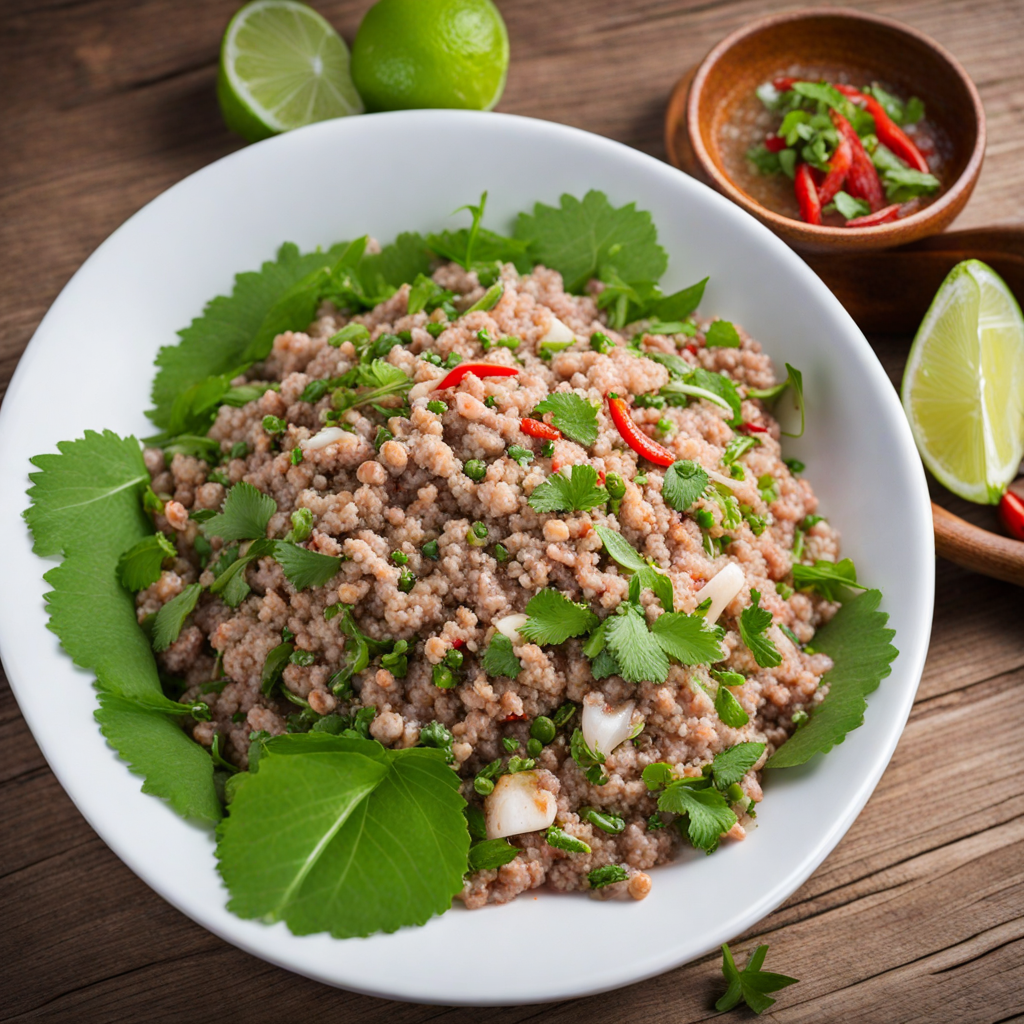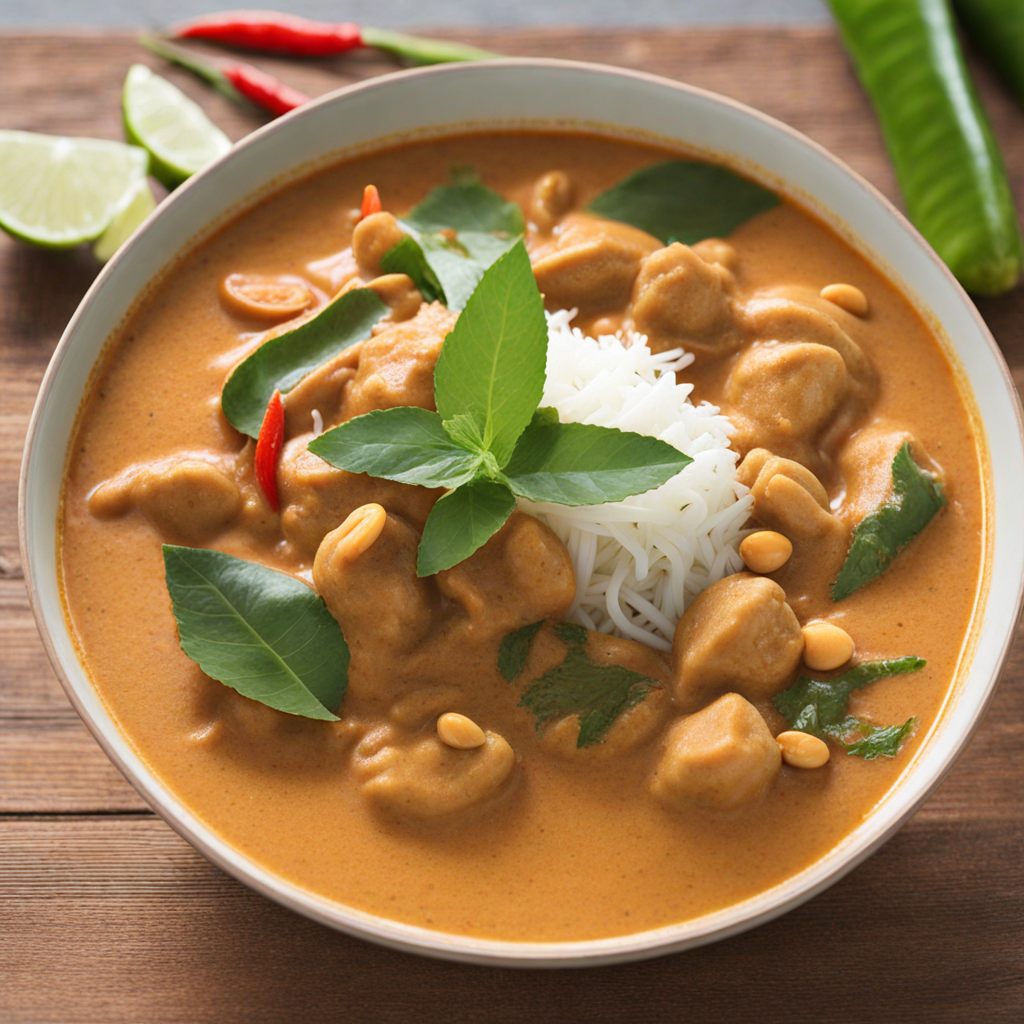Thai Iced Tea
Thai Iced Tea is a vibrant and refreshing beverage that beautifully encapsulates the essence of Thailand's rich culinary traditions. This delightful drink is made from strong brewed black tea, often infused with spices such as star anise and crushed tamarind, which contribute to its unique flavor profile. The tea is typically brewed to a robust strength, allowing it to hold its own when mixed with creamy elements. As it brews, the deep amber hue of the tea deepens, hinting at the bold taste that awaits. Once the tea is prepared, it is sweetened generously with sugar, and then combined with evaporated milk or sweetened condensed milk, imparting a luscious creaminess that perfectly balances the tea's astringency. The vibrant orange color of the final drink is visually striking, making it an inviting option for those looking to experience something new. Served over ice, Thai Iced Tea is incredibly refreshing, making it a popular choice in the hot Thai climate. The enjoyment of Thai Iced Tea goes beyond mere taste; it is a sensory experience that combines the sweet, creamy, and spiced notes with the coolness of ice. Each sip transports you to the bustling streets of Thailand, where street vendors serve this beloved drink to locals and tourists alike. Whether enjoyed as a midday pick-me-up or a delightful accompaniment to a spicy meal, Thai Iced Tea is a must-try for anyone looking to explore the intriguing flavors of Thailand.
How It Became This Dish
A Journey Through the Rich History of Thai Tea (ชาไทย) Introduction Thai tea, or "ชาไทย" (cha Thai), is a vibrant and aromatic beverage that has captured the hearts of tea lovers worldwide. This distinctive drink, with its deep amber hue and sweet, creamy flavor, is a cultural emblem of Thailand, often enjoyed iced or hot. To appreciate this beloved beverage fully, we must delve into its origins, cultural significance, and evolution over time. Origins: The Birth of Thai Tea The roots of Thai tea can be traced back to the 19th century when Thailand was known as the Kingdom of Siam. While tea itself is not indigenous to Thailand, the country began importing tea from China in the early 1800s. Initially, it was primarily consumed by the elite and aristocracy. However, as trade routes expanded and the influence of British colonialism spread through Southeast Asia, tea became more accessible to the broader population. The unique flavor profile of Thai tea as we know it today emerged when local farmers and merchants began experimenting with various tea blends. A popular version of Thai tea is made from "Ceylon" tea, which is a robust black tea variety. This is often combined with a blend of spices, including star anise, crushed tamarind seed, and sometimes even orange blossom, creating a fragrant and flavorful infusion. Cultural Significance Thai tea is more than just a beverage; it is a cultural icon that reflects the social fabric of Thailand. It is often served in teahouses, street stalls, and restaurants throughout the country, where it is enjoyed by locals and tourists alike. The drink has become synonymous with the Thai way of life, characterized by hospitality and warmth. In Thai culture, tea is often associated with communal gatherings and celebratory occasions. It is common for families to serve Thai tea during social events, festivals, and religious ceremonies. For instance, during the Songkran Festival, which marks the Thai New Year, vendors sell Thai tea alongside traditional foods. The drink serves not just as a refreshment but also as a symbol of togetherness and celebration. Moreover, Thai tea has found its way into the culinary realm, with its distinct flavor being incorporated into various Thai desserts and dishes. The iconic Thai tea ice cream and Thai tea-flavored pancakes are just a couple of examples of how this beverage has inspired and influenced the country’s gastronomy. The Evolution of Thai Tea As Thailand began to embrace tourism in the late 20th century, Thai tea's popularity soared beyond its borders. With the influx of international visitors, many sought to experience authentic Thai cuisine, and Thai tea quickly became a staple in Thai restaurants worldwide. The drink's eye-catching color and delightful taste made it a favorite among food enthusiasts. In the 1990s, the globalization of food trends saw the emergence of Thai tea as a trendy beverage in cafes and restaurants in Western countries. It was during this time that the traditional preparation methods began to adapt to modern palates. Many establishments started to offer Thai tea in varied forms, such as Thai tea lattes, bubble tea with Thai tea flavor, and even Thai tea-flavored cocktails. One of the significant developments in the world of Thai tea has been the standardization of its preparation. Traditionally, Thai tea was brewed using a simple process involving boiling water and steeping the loose tea leaves, often strained through a fine cloth. However, in the United States and other countries, many cafes and restaurants now use pre-packaged Thai tea mixes that simplify the brewing process. While this has made Thai tea more accessible, it has raised discussions about authenticity and the preservation of traditional methods. The Contemporary Scene: Thai Tea Today Today, Thai tea continues to thrive both in Thailand and internationally. In Thailand, the drink is commonly enjoyed on the streets, often served in plastic cups with ice, a generous helping of sweetened condensed milk, and sometimes topped with evaporated milk for a creamy finish. The iced version, known as "ชาไทยเย็น" (cha Thai yen), is especially popular among locals seeking relief from the tropical heat. In the United States and other countries, Thai tea has experienced a wave of creativity, with new variations and fusions emerging. Cafes have introduced innovative spins on the classic drink, experimenting with flavors like coconut, vanilla, and even matcha-infused Thai tea. The rise of bubble tea shops has also led to the inclusion of Thai tea in bubble tea offerings, where it is paired with chewy tapioca pearls, adding a fun and textural element to the experience. Moreover, the global trend towards health and wellness has prompted some tea enthusiasts to explore organic and premium varieties of Thai tea. As awareness of the health benefits of tea grows, many consumers are seeking high-quality loose-leaf teas that retain the authentic flavors and aromas of traditional Thai tea. Conclusion The history of Thai tea is a fascinating tale of cultural exchange, adaptation, and evolution. From its humble beginnings in the 19th-century Siam to its status as a global beverage phenomenon, Thai tea embodies the essence of Thai culture – a blend of tradition and modernity, community and hospitality. As it continues to adapt to changing tastes and preferences, Thai tea remains a beloved drink that connects people across cultures and generations, inviting everyone to savor its rich flavors and history. Whether enjoyed in a bustling Bangkok street market or a cozy café in New York, Thai tea will always carry with it the spirit of Thailand.
You may like
Discover local flavors from Thailand


